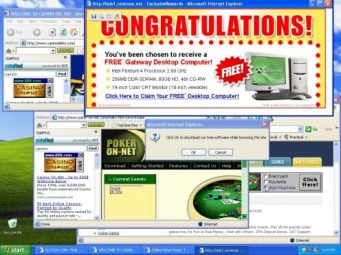Graffiti of the 21st Century & Its Influences.
Pop-up Ads - the Invasion of Space
Example of a Desktop covered with unwanted pop-up advertisements.
- Originally, pop-up windows were often used by companies who want to provide additional information to users about certain topics. For example, McAfee, a computer software company, used pop-up windows as a way for users to download content from their website. However, this service no longer exist due to the negative connotation that pop-up windows currently have now.
- This negative perspective of pop-up windows originated when corporations and companies began to look at pop-up windows with a capitalistic outlook. These corporations and companies took advantage of the pop-up window and created a new use for them. This is known as the pop-up ad(vertisements).
- Pop-ad ads often promote a product or collects personal information from internet users, which ultimately benefits companies who uses them.
- The main feature of pop-up windows/ads is the fact that users who enters a website voluntarily, is unaware that they will also be entering into another website, involuntarily -thus causing an invasion of space.
Comparisons to Graffiti
- Pop-up ads invade the physical private viewing space of the internet user. They are forced to see the pop-up ad, whether or not they chose to. Like graffiti artwork displayed on physical properties, those who are within distance to view the physical property, may involuntarily view the graffiti artwork.
- Depending on the content of the pop-up window, the content can have artistic value, carry important social activism message, advertisements, or contain important information that can benefit those who views it. This is similar to physical graffiti because graffiti artwork can contain all these elements as well
- Pop-up windows are viewed negatively. There are often many internet companies who created software that will eliminate the possibility of pop-up windows from appearing when one is on the internet. Likewise to graffiti creations in the physical world, there are many companies whose sole purpose is to get rid of graffiti on physical properties.
- There needs to be a required knowledge of a certain skill set in order to create the graffiti work. In terms of pop-up windows, one has to be able to know how to use HTML or JavaScript in order to create the pop-up window. Without this knowledge, the pop-up window will not exist.
- It is not limited to one style or canvas and can exist in many forms. Physical graffiti can be spray painted, drawn with pencil or painted on the walls of schools, malls, and other properties. Likewise, the pop-up windows exist in other forms such as the pop-under windows and ads that are within the content of something that one is viewing. An example of this is the advertisements that are placed and embedded on YouTube videos.
- (Right) Video by Michelle Pham, a make up guru. When viewing the video, a deviation of the pop-up window appears at the bottom of the video. This type of pop-up window is in the form of advertisements, provided by Google. The viewer of the video is forced to see the ad involuntarily.
Differences from Physical Graffiti
- This type of digital graffiti has the ability to track and collect personal information from those who view the pop up window, whether voluntarily or involuntarily. This is due to the technological advances that allows it to happen. Physical graffiti does not have this ability because they are static works of arts that are not connected to anything.
- While physical graffiti are often associated as a subculture, digital graffiti in this form is a cultural norm on the internet. Although pop-up windows and advertisements are undesired, those who are are familiar with the internet and are frequent users of it do not find pop-up windows as an act of the subculture. Conversely, pop-up windows are part of the mainstream culture and nowadays, they are used by corporations and other companies who seek to collect data in order to help make profits.

